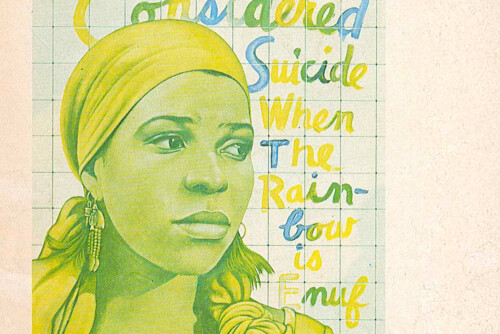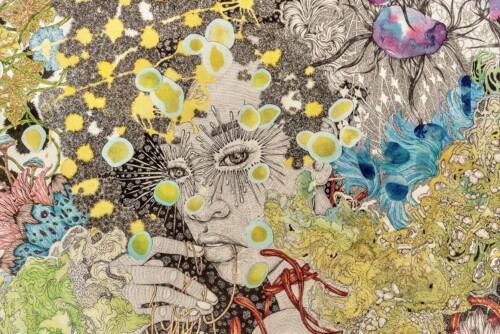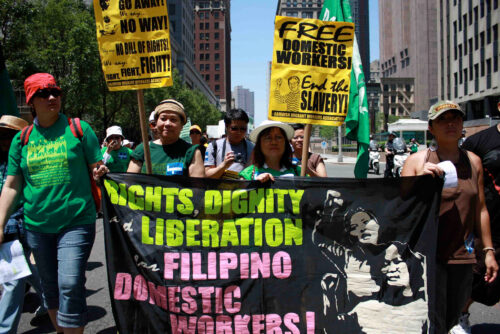it is possible to start a phrase with a word and end with a gesture/ that’s how I’ve lived my life/ that’s how I continue to study /produce black art
—Ntozake Shange, “why I had to dance”1
In the academic year 2012-2013, renowned poet, performance artist, playwright, and novelist Ntozake Shange, Barnard class of 1970, came back to the Barnard College campus in high style. “‘An Art That Was Rightfully Mine’: The Worlds of Ntozake Shange,” a yearlong series of literary, scholarly, and performative events in Shange’s name, animated the Barnard campus. Celebrating her prodigious accomplishments as a black feminist artist who exemplifies originality, generosity, interdisciplinarity, as well as intellectual and creative rigor, the “Year of Shange” also recognized the institutional changes that had been accomplished in her spirit and that made the celebration possible: the elevation of the revived Africana Studies program to departmental status after decades of campus activism; the hiring and retention of eight tenured faculty who populate the department (six of whom are black women); and the creation of the Consortium for Critical Interdisciplinary Studies (CCIS), a intellectual and curricular project undertaken by Africana Studies; American Studies; and Women’s, Gender, and Sexuality Studies, in collaboration with the Barnard Center for Research on Women.
Africana Studies, like Shange’s most well-known work, for colored girls who have considered suicide / when the rainbow is enuf, had moved from the margins of intellectual production to a center of sorts. The “Worlds of Shange” symposium signaled the realization of a vision nurtured by Barnard’s black community and alive in the works of Barnard’s distinguished black women alumnae—in particular, icons of black feminism including Zora Neale Hurston (BC ’28), Ntozake Shange (BC ’70), Thulani Davis (BC ’70), and Edwidge Danticat (BC ’90). After years of institutional work, our “Year of Shange” gave us a chance to live this vision, outlined in Tina Campt’s opening remarks:
[This conference] is a tribute to those who made it possible to dignify the cultures, histories, artistic productions, and political visions of African diasporic people, and to recognize their value as subjects and agents of scholarly and artistic merit, rather than as objects of analysis or exclusion.
Barnard faculty came together to read and analyze Shange’s work; alumnae came from New York and around the country to join in conversations about for colored girls, the choreopoem, and For Colored Girls, the major motion picture; current students and recent alumnae created an original performance inspired by Shange’s works that featured dance, music, and poetry; and distinguished scholars from all over the country gathered at Barnard for an historic conference dedicated to Shange’s oeuvre. At these events, they also discussed Some Sing, Some Cry, Shange’s latest novel, written in collaboration with her sister, Ifa Bayeza; the “choreoessays” in lost in language & sound, a collection of aesthetic statements beautifully examining her challenging yet accessible range of work; and her increasingly public discussion of disability and aging.2
Shange’s world is deep and wide; her miraculous accomplishment is that she has made a place for all of us in it. As seen throughout the volume and discussed later in this introduction, her work, at once global/ “pan-hemispheric” and intensely personal, makes space for others’ songs about a range of human experiences. Thus it is unsurprising that her works are taught in countless classrooms across the country and the globe—Shange appears on high school and university syllabi in American and African American literature classes, in courses on theater and performance studies, and in gender and sexuality studies departments. Shange’s work is performed on college campuses every year, adapted in countless ways to reflect the cultural politics of each site; it can be seen in US women’s prisons as drama therapy; it appears in the cultural centers of East and West Africa (Nairobi, Lagos), easily adapted (or not) to lives of the women living there. In these diverse settings, Shange’s work is chosen for the way in which, according to Nigerian director Wole Oguntukun, it has the ability to enable people to “see their world through the eyes of others . . . [to] see the things that a lot of people don’t think, basically. . .theater tries to shake them out of complacency and tries to make them remember that there is trouble out there.” Chronicling the trouble in here and “out there,” providing poetic rituals, actual and metaphorical recipes as healing solutions, Shange’s “world” has been transformative of our own, on local and global scales.
Shange’s Impact
If Shange’s major impact can be described as a kind of “world-making,” then this world might best be described as one in which border crossings—of influence, geography, and genre—articulate the land. In an early essay, Ntozake Shange meditates on what it means for an African American writer to confront (or not) Anglophone literary history and tradition. Worried about all of the effort black people have made to engage Western “classics” to fit their particular histories and concerns, Shange decides that, “I owe not one more moment of thought to the status of European masters. I don’t have to worry that Ira Aldridge thinks poorly of me for not accepting a challenge/ the battle is over. I am settling my lands with my characters, my language, my sense of right & wrong, my sense of time & rhythm. The rest of my life can go along in relative aesthetic peace/ the enemy has been banished from my horizons.”3 Although this essay was written in the 1970s, it functions as an “artist’s statement” for her entire oeuvre, which, thankfully, is still in progress. For Shange, the most important aspect of her work has been the creation and population of worlds inhabited by “her people,” simultaneously creating a nurturing and challenging space for them to breathe, flourish creatively, heal themselves and others, and inspire spiritual and perspectival transformation. This world is constituted in and by extra/ordinary black men and women, boys and girls, elders and ideas who communicate with each other and us in a language that is indeed “Shange’s” and “our” own. Her language is an English syncopated and elongated to capture the essence of not only what needs to be said, but also the way in which these thoughts must be expressed. Shange’s “sense of right and wrong,” her moral vision, as expressed by the truth-telling of individual black women or women of color, engenders a world which redefines community, citizenship, and justice. Paying attention to her own “sense of time and rhythm” has enabled her to work at the edge of innovation, a place that is oxymoronically wholly original, yet inviting to ancestors and futurity. Wanting to be a “primary source” instead of a reference book, Ntozake Shange has created black classics, grounded in her people and her language, which are new and fresh each and every time and place they are read, performed, and adapted.
Just as she put aside the “European masters,” and their classic texts, she has been similarly compelled to modify, translate, and transform the “King’s English” to better express the knowledge, experience, ironies, expansiveness, and pleasures of black diasporic lives. She began this task with her own name, exchanging Pauline L. Williams for Ntozake, which means “she who has her own things” in Xhosa (literally “things that belong to her”) and Shange, which means “he/she who walks/lives with lions” (literally “the lion’s pride”) in Zulu.
Refusing to take Shakespeare as her only literary forebear, Shange looks instead to more home-grown (even down-home) wordsmiths, in particular the anthropologist Zora Neale Hurston (BC ’28), who, during a time when black writers were perhaps overly concerned with reaching white/Western standards of literary merit, championed the language of the folk.4 Hurston wrote in a black vernacular that was—to coin a Hurstonism—“actional;” words and phrases in “Sweat” and Their Eyes Were Watching God have the ability to sing, to laugh, to cry, to “ironize.” Highly metaphorical and also entirely realistic, Hurston’s English, the form of her “Negro expression,” was dramatic and angular, wholly original. Shange’s English takes Hurston’s innovations deeper into the realm of sound—her lack of capitalization, spelling and grammar modification, and use of the dash and the slash all transform English into a living and breathing language that indicates on the page the fact that it was also once in the mouth. To read Shange, either to oneself or out loud, requires physical and cognitive adjustments. To experience Shange, you must cross over into her linguistic world and ruminate there. “Settling my lands,” means finding transnational language(s) of communication, a necessity as her people are Hispanic, Francophone, and Lusophone, too.
Sui generis in terms of both form and language, Shange has also addressed subjects and topics in her work that previously had not been afforded significant literary and lyrical treatment. As an artist who chooses to center her work on the dangers and pleasures of being a black woman and/or girl, Shange has become one of the defining figures in the history of black feminism, one of the women who has composed countless celebratory and mournful “black girl’s songs.” In for colored girls alone, Shange brought to the page/stage poems that addressed the “metaphysical dilemma” of “bein a woman & bein colored.”5 For her, this conundrum includes the silencing of black women and girls due to the “double bind” of racial and gender oppression, domestic violence and rape, abortion, competing and debilitating standards of beauty, Post-Traumatic Stress Disorder, and AIDS. Her other works take up these and other salient topics that resonate in and with contemporary American culture: the politics of cultural appropriation and modern minstrelsy (spell #7), the politics of food and food culture(s) (if I can Cook), and the legacy and impact of the Civil Rights movement and school desegregation (Betsy Brown, Liliane), to name a few.
It is in the depth and breadth of her subject matter that we see Shange’s moral vision, her “sense of right and wrong.” To make use of a very contemporary phrase, “black lives matter” to Shange, they are her beginning and ending. In particular, the lives of black women and girls matter—Shange writes to ennoble, encourage, and protect their paths to womanhood and self-realization. In this, she anticipates present-day initiatives like the African American Policy Forum’s #WhyWeCan’tWait, which focuses on black girls, thus realigning President Obama’s My Brother’s Keeper campaign to improve and save the lives of black boys.6 In focusing her work on the creation of a literature for these girls, to reflect their experiences and also to spur their dreams, Shange has created a space of safekeeping and recognition that benefits us all.
- Ntozake Shange, lost in language & sound or how I found my way to the arts: essays (New York: St. Martin’s Griffin, 2011). [↩]
- See Felicia Lee, “A Writer’s Struggles, on and off the Page,” The New York Times 17 Sept. 2010. [↩]
- Shange, lost in language & sound 2011: 43. [↩]
- See Monica L. Miller, ed., “‘Jumpin’ at the Sun’: Reassessing the Life and Work of Zora Neale Hurston,” The Scholar & Feminist Online 3.2 (2005). [↩]
- Shange, for colored girls who have considered suicide / when the rainbow is enuf (New York: Scribner, 2010) 45. [↩]
- See http://www.aapf.org/mybrotherskeeper. [↩]




